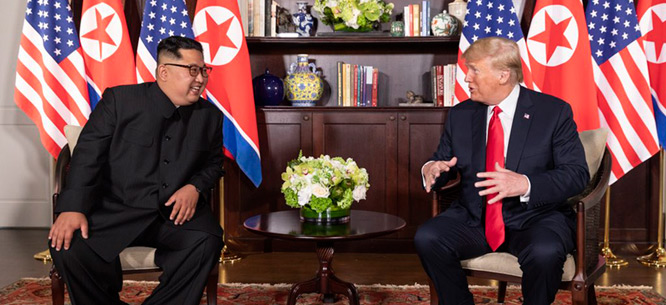The Lasting Implications of the Singapore Summit
The Lasting Implications of the Singapore Summit
The long-awaited summit between Donald Trump and Kim Jong-un ended in a diplomatic agreement with the substance of cotton candy. But it nevertheless marked an important step forward in the Korean peace process.

“Trump and Kim’s Excellent Adventure”—otherwise known as the Singapore Summit—is easy to trash, and just about everyone has been. Takeaways include a diplomatic agreement with the substance of cotton candy. Donald Trump saluted a North Korean general while hawking the country’s beaches like the Atlantic City real-estate and casino developer he is. Kim Jong-un tried to climb into Trump’s tricked-out Cadillac until his body guards gently restrained him (was he hoping to defect?). Dennis Rodman cried on televisions around the world in a “Make America Great Again” hat and a PotCoin.com T-shirt.
While the outcomes of June 12, 2018 may be intangible, they are nonetheless significant. Is it possible to see the summit’s potential without embracing Trumpism or North Korean gulags, given the history-defying nature of this history-making moment?
The current “winning/losing” narrative casts the United States as summit “loser” because of Trump’s bravado and his willingness to accede to some North Korean demands. What, though, would it mean for North Korea to be the “loser”? At this stage of the game, it would likely mean war—a nuclear war—that Secretary of Defense James Mattis anticipates as “probably the worst kind of fighting in most people’s lifetimes.” Conservative projections, such as from the RAND corporation, detail hundreds of thousands, if not millions, of casualties (Korean, American, Japanese, and Chinese) followed by hundreds of thousands of U.S. and South Korean troops rushing into North Korea to secure the territory. (There is little mention of safeguarding the “mop-up” troops from the radiological nightmare that would follow).
The handshake that shook the world is worse?
Korea has long been Northeast Asia’s best piece of real estate. With year-round accessible harbors and abundant resources, during the modern era alone Korea endured Russian, Chinese, Japanese, and American attempts to control its land and people. In 1871, the United States was first out of the gate with “Our Little War with the Heathen” (in the racialized terminology of the day), which counted three dead Americans and 243 dead Koreans—establishing a disproportionate casualty ratio between Koreans and foreign invaders that would continue through the twentieth century.
The Singapore Summit hit “pause” on the scenario of more war to control the Korean Peninsula, proffering economic development and sanctions relief in exchange for Pyongyang dismantling its nuclear weapons program. Jokes about Trump Towers and casinos in North Korea dominated American coverage. Donald Trump has regularly appeared in recent South Korean cartoons as Napoleon or a Roman emperor. Yet together with North Koreans, South Koreans would bear the brunt of any future war. The day after the summit, they accordingly demonstrated their overwhelming rejection of such a future in a nationwide election that saw landslide victories for candidates supporting the peace process—including governorships in regions of South Korea that have never favored such policies. South Korean president Moon Jae-in is enjoying an 80 percent approval rate for betting Korea’s future this way, and although North Koreans lack avenues for open expression under the current regime, for the first time ever, the state-controlled North Korean media is publishing articles about easing military tensions with South Korea and the United States.
With its over-the-top, made-for-Hollywood moments and unusually vague diplomatic assurances, the summit inadvertently succeeded in doing two things that will challenge the regime and ordinary North Koreans in the months to come in new and important ways. Only a few months ago, at the height of the “fire-and-fury” rhetoric, the United States would likely have found little, if any, international support for countering a North Korean missile test with the arsenal Washington still threatens to use. The onus has shifted, however, compelling North Korean leaders to desist from what policy wonks call Pyongyang’s “provocation cycle” (they test; we sanction; they test; we offer aid or sanctions relief; they test again; we sanction again; and so on). Now, were he to launch a missile, Kim Jong-un would likely lose all of the “likes” he generated posing for selfies and cruising through the streets of Singapore.
The success of the summit also means that we can focus on the humanitarian disaster that has been daily life for so many North Koreans for too long. We have known about the work camps, death camps, hereditary suffering, hunger, and deprivation for decades. Kim Jong-un has, too, and he knows we know. Fighting these abuses by launching missiles at North Korea only exacerbates these conditions, however, and enables the North Korean leadership to justify sustaining them. Opening North Korea to the world is the only way to change this: whether it means allowing international aid agencies entry to help alleviate tuberculosis, permitting foreign entrepreneurs to bolster North Korean efforts to restart or reconceive failed industries, or establishing wind farms in a country where energy is an immediate need. Then, when Koreans finally own their society and can hold their leaders accountable, we can measure what happened in Singapore in June 2018. Until that point, if we really are interested in a peaceful and progressive future for Korea, we need to work with what we’ve got—on both sides of the Pacific.
Alexis Dudden is professor of history at the University of Connecticut.






